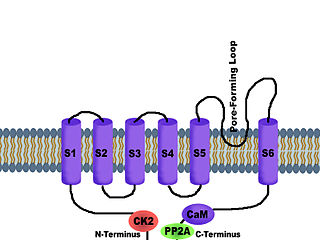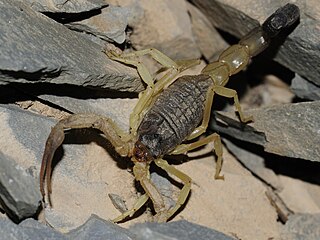Related Research Articles

Charybdotoxin (ChTX) is a 37 amino acid neurotoxin from the venom of the scorpion Leiurus quinquestriatus hebraeus (deathstalker) that blocks calcium-activated potassium channels. This blockade causes hyperexcitability of the nervous system. It is a close homologue of agitoxin and both toxins come from Leiurus quinquestriatus hebraeus. It is named after Charybdis, a sea monster from Greek myth.

Prazosin, sold under the brand name Minipress among others, is a medication used to treat high blood pressure, symptoms of an enlarged prostate, and nightmares related to post-traumatic stress disorder (PTSD). It is an α1 blocker. It is a less preferred treatment of high blood pressure. Other uses may include heart failure and Raynaud syndrome. It is taken by mouth.

SK channels are a subfamily of calcium-activated potassium channels. They are so called because of their small single channel conductance in the order of 10 pS. SK channels are a type of ion channel allowing potassium cations to cross the cell membrane and are activated (opened) by an increase in the concentration of intracellular calcium through N-type calcium channels. Their activation limits the firing frequency of action potentials and is important for regulating afterhyperpolarization in the neurons of the central nervous system as well as many other types of electrically excitable cells. This is accomplished through the hyperpolarizing leak of positively charged potassium ions along their concentration gradient into the extracellular space. This hyperpolarization causes the membrane potential to become more negative. SK channels are thought to be involved in synaptic plasticity and therefore play important roles in learning and memory.

Calciseptine (CaS) is a natural neurotoxin isolated from the black mamba Dendroaspis p. polylepis venom. This toxin consists of 60 amino acids with four disulfide bonds. Calciseptine specifically blocks L-type calcium channels, but not other voltage-dependent Ca2+ channels such as N-type and T-type channels.
Tityustoxin is a toxin found in the venom of scorpions from the subfamily Tityinae. By binding to voltage-dependent sodium ion channels and potassium channels, they cause sialorrhea, lacrimation and rhinorrhea.

Slotoxin is a peptide from Centruroides noxius Hoffmann scorpion venom. It belongs to the short scorpion toxin superfamily.

Maurotoxin is a peptide toxin from the venom of the Tunisian chactoid scorpion Scorpio maurus palmatus, from which it was first isolated and from which the chemical gets its name. It acts by blocking several types of voltage-gated potassium channel.

Margatoxin (MgTX) is a peptide that selectively inhibits Kv1.3 voltage-dependent potassium channels. It is found in the venom of Centruroides margaritatus, also known as the Central American Bark Scorpion. Margatoxin was first discovered in 1993. It was purified from scorpion venom and its amino acid sequence was determined.
Tamapin is a toxin from the Indian Red Scorpion, which is a selective and potent blocker of SK2 channels.
Kaliotoxin (KTX) inhibits potassium flux through the Kv1.3 voltage-gated potassium channel and calcium-activated potassium channels by physically blocking the channel-entrance and inducing a conformational change in the K+-selectivity filter of the channel.

Hottentotta is a genus of scorpions of the family Buthidae. It is distributed widely across Africa, except for most of the Sahara desert. Species in the genus also occur in the Middle East, the Arabian Peninsula, southeastern Turkey, Iraq, Iran, Afghanistan, Pakistan, India, Nepal, Cape Verde Islands, and Sri Lanka (introduced).
Himmatrao Saluba Bawaskar is an Indian physician from Mahad, Maharashtra. He is known for his research on treatment for scorpion stings. Much of his work has been published in the British medical journal The Lancet. He has also conducted research in the fields of snake bites, cardiovascular diseases, and hypothyroidism.

Pandinotoxins are toxins from the venom of the emperor scorpion Pandinus imperator. They are selective blockers of voltage-gated potassium channels
Anuroctoxin is a peptide from the venom of the Mexican scorpion Anuroctonus phaiodactylus. This neurotoxin belongs to the alpha family of potassium channel acting peptides. It is a high-affinity blocker of Kv1.3 channels.

Pi3 toxin is a purified peptide derivative of the Pandinus imperator scorpion venom. It is a potent blocker of voltage-gated potassium channel, Kv1.3 and is closely related to another peptide found in the venom, Pi2.
Tamulotoxin is a venomous neurotoxin from the Indian Red Scorpion.
HsTx1 is a toxin from the venom of the scorpion Heterometrus spinifer. HsTx1 is a very potent inhibitor of the rat Kv1.3 voltage-gated potassium channel.
Pi4 is a short toxin from the scorpion Pandinus imperator that blocks specific potassium channels.
Limbatustoxin, is an ion channel toxin from the venom of the Centruroides limbatus scorpion. This toxin is a selective blocker of BK channels, calcium-activated potassium channels.

Noxiustoxin (NTX) is a toxin from the venom of the Mexican scorpion Centruroides noxius Hoffmann which block voltage-dependent potassium channels and calcium-activated potassium channels.
References
- 1 2 Galvez, A; Gimenez-Gallego, G; Reuben, JP; Roy-Contancin, L; Feigenbaum, P; Kaczorowski, GJ; Garcia, ML (1990). "Purification and characterization of a unique, potent, peptidyl probe for the high conductance calcium-activated potassium channel from venom of the scorpion Hottentotta tamulus". The Journal of Biological Chemistry. 265 (19): 11083–90. doi: 10.1016/S0021-9258(19)38560-6 . hdl: 10261/177752 . PMID 1694175.
- ↑ Ferrat, G; Bernard, C; Fremont, V; Mullmann, TJ; Giangiacomo, KM; Darbon, H (2001). "Structural basis for alpha-K toxin specificity for K+ channels revealed through the solution 1H NMR structures of two noxiustoxin-iberiotoxin chimeras". Biochemistry. 40 (37): 10998–1006. doi:10.1021/bi010228e. PMID 11551195.
- 1 2 Candia, S; Garcia, ML; Latorre, R (1992). "Mode of action of iberiotoxin, a potent blocker of the large conductance Ca(2+)-activated K+ channel". Biophysical Journal. 63 (2): 583–90. Bibcode:1992BpJ....63..583C. doi:10.1016/S0006-3495(92)81630-2. PMC 1262182 . PMID 1384740.
- 1 2 Bawaskar, HS; Bawaskar, PH (1992). "Management of the cardiovascular manifestations of poisoning by the Indian red scorpion (Hottentotta tamulus)". British Heart Journal. 68 (5): 478–80. doi:10.1136/hrt.68.11.478. PMC 1025191 . PMID 1467032.